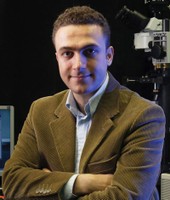Podcast: Play in new window
BOB HIRSHON (host):
A smartphone microscope. I’m Bob Hirshon and this is Science Update.

A lightweight attachment can turn a smartphone into a powerful fluorescent microscope. Aydogan Ozcan, a professor at the UCLA School of Engineering, is leading its development. The attachment enables an ordinary smartphone to detect incredibly tiny particles.
AYDOGAN OZCAN (University of California, Los Angeles):
So that you can visualize, through the screen of the phone, individual viruses which are on the order of 100 to 200 nanometers. Extremely small. And just to give you an idea, the human hair diameter is on the order of a hundred thousand nanometers.
HIRSHON:
That’s not to say that you just snap a picture of the virus. The attachment lights up a liquid or solid sample with a laser, and captures fluorescent light from the particles it’s looking for. The device weighs about six and a half ounces. Potential applications range from detecting disease-causing germs to scanning for traces of bomb material. I’m Bob Hirshon for AAAS, the Science Society.

